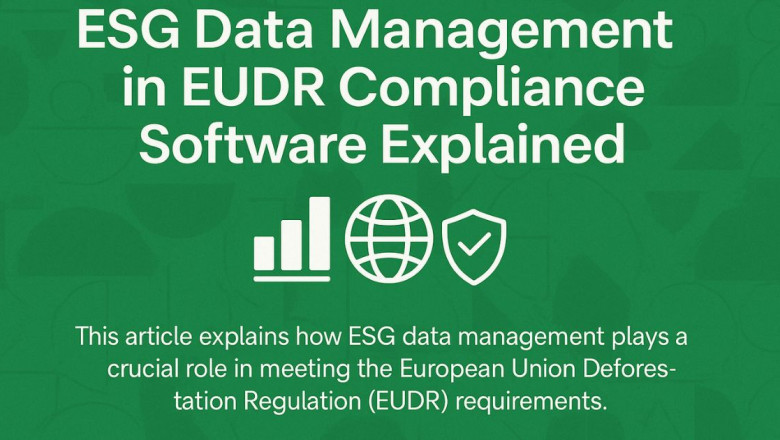views
As sustainability regulations tighten across industries, companies are rapidly adopting advanced digital tools to manage and report environmental, social, and governance (ESG) data. A focus of increased examination is the European Union Deforestation Regulation (EUDR), which requires companies to demonstrate that their products are not associated with deforestation. Effective ESG data management is at the core of meeting these requirements. Eudr Compliance Software is emerging as a critical tool to streamline this process and ensure businesses meet regulatory expectations efficiently.
Understanding EUDR and Its Data Demands
The EUDR came into effect in 2023 and focuses on seven key commodities—palm oil, soy, coffee, cocoa, cattle, timber, and rubber. Businesses introducing these products into the EU market must guarantee they are free from deforestation and produced lawfully. This regulation applies to both EU and non-EU entities, meaning any business in the supply chain is potentially impacted.
What makes compliance challenging is the sheer volume of data required. Companies must gather, verify, and submit geolocation coordinates of land plots, supply chain data, product origin proof, and risk assessments. These data points must be collected at scale, often from global suppliers, and stored in formats that allow traceability and auditability.
Role of ESG Data in EUDR Compliance
At the heart of EUDR compliance lies ESG data management. ESG data provides the foundation for proving deforestation-free sourcing and responsible supply chains. Here's how ESG data intersects with EUDR requirements:
- Environmental Data: Includes land use records, satellite imagery, and forest cover data to verify that no deforestation occurred after the December 31, 2020 cutoff date.
- Social Data: Documents fair labor practices and community engagement in sourcing areas, which may be subject to additional due diligence.
- Governance Data: Involves contracts, legal documentation, and risk management policies that demonstrate corporate accountability and legal compliance.
Effective ESG data management helps companies link this diverse information into a cohesive story that aligns with EUDR demands.
Key Features of ESG-Focused EUDR Compliance Platforms
Modern EUDR compliance tools are tailored to handle large-scale ESG datasets with accuracy and efficiency. Here's what a robust platform typically includes:
1. Supply Chain Mapping and Traceability
A feature is the ability to map the supply chain, from farm to finished product. Platforms use AI and blockchain technologies to create immutable, real-time records. This not only aids in transparency but also makes it easier to detect risks and rectify them before regulatory reporting deadlines.
2. Automated Data Collection
Instead of manual data gathering, compliance platforms often integrate with third-party APIs, satellites, and supplier portals to pull in land-use data, forest risk indices, and farm-level geolocations. Automation reduces human error and speeds up verification.
3. Geolocation and Satellite Integration
Because geolocation data is central to proving deforestation-free status, many solutions incorporate GIS (Geographic Information System) technology. Users can overlay supply chain coordinates with satellite maps to visually confirm forest coverage or detect illegal clearing.
4. Risk Assessment Modules
Risk assessment engines score supplier regions based on deforestation history, governance stability, and compliance behavior. Companies can use these insights to prioritize due diligence efforts and document risk mitigation strategies for regulators.
5. Audit Trail and Documentation
Good compliance software maintains a detailed audit trail for every data entry, change, or supplier report. This is essential in case of EU audits or third-party reviews. Reports can be generated in structured formats aligned with the regulation’s expectations.
Benefits of Strong ESG Data Management for EUDR
Investing in ESG data capabilities brings several advantages beyond regulatory compliance:
- Operational Efficiency: Automating data collection and risk assessments frees up resources and reduces turnaround time.
- Reputation Management: Companies that demonstrate transparency and sustainability are better positioned to win consumer trust and investor interest.
- Market Access: EUDR non-compliance can result in blocked access to the EU market. Robust ESG data systems safeguard continuity.
- Future-Proofing: As regulations evolve, companies with integrated ESG data systems can adapt more easily and expand their reporting scope.
Challenges in ESG Data Integration
While the benefits are clear, integrating ESG data into compliance workflows isn’t without hurdles:
- Data Silos: ESG data is often scattered across departments or external systems, making integration complex.
- Supplier Engagement: Small-scale suppliers may lack digital infrastructure to provide required data consistently.
- Data Accuracy: Verifying the authenticity of satellite coordinates, documentation, and certificates requires continuous oversight.
- Scalability: Global supply chains involve thousands of data points. Without scalable architecture, systems can become overloaded.
Overcoming the challenges requires a strategy that combines technology, governance frameworks, and supplier collaboration.
The Role of ESG Reporting Software
While EUDR-specific platforms focus on compliance data, broader Esg Reporting Software plays a complementary role. These tools aggregate ESG metrics across operations, from emissions tracking to community impact, and are often used for sustainability disclosures and investor communications. Integrating both platforms allows businesses to maintain a unified ESG strategy—balancing regulatory needs with corporate responsibility goals.
Conclusion
As the EUDR introduces a new era of supply chain accountability, ESG data management becomes the linchpin for compliance and sustainable business practices. Advanced software tools are indispensable in this journey, offering automation, traceability, and risk mitigation at scale. Whether you’re a producer, importer, or retailer, investing in the right digital infrastructure today will prepare your organization for the increasingly transparent and regulated future of global trade.














Comments
0 comment